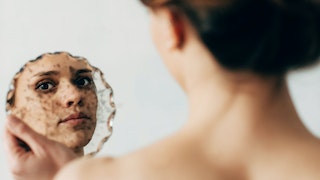Injectable Wrinkle Reducers
How To Safely Manage Your Cystic Acne At Home, According To A Dermatologist
Thespotlyte | August 04, 23

Even the most skincare-savvy individuals would love to get insider intel from a dermatologist. But sometimes, it’s hard to ask a doctor your most burning questions — maybe you believe your concern is too trivial, or you’re embarrassed to get the answer in a face-to-face appointment. That’s why Spotlyte brings you Ask a Derm, a regular column where we have professionals provide the answers to your questions, no matter how big or how small. In this installment of Ask a Derm, Dr. Ava Shamban explains how to detect cystic spots, what the causes of cystic acne are, and how to manage it— even when you’ve tried to mess with it.
When it comes to the royal court of pimples and blemishes, cystic acne could be considered the queen mother. No matter how much you poke, prod, or pick away at these underground masses, they almost always reign supreme. “It tends to be the most severe form of acne, the most inflammatory, and the most difficult to treat,” explains Dr. Ava Shamban, a Beverly Hills dermatologist and founder of Ava MD and Skin Five.
While blackheads and whiteheads are pustular (as in, filled with gunk that expels once it comes to a head), cystic acne can be defined as the presence of physical cysts, which Dr. Shamban describes as “reddish papules that are about half a centimeter in size and above.” They typically appear on the skin in groups, either on the face, chest, back, or a mixture of all of the above. The easiest way to identify cystic spots is if you feel a tender, almost reverberating pain when you even just gently press on it. “That’s related to the inflammation,” Shamban explains. “Anytime you have anything inflamed, it’s going to hurt. By its very nature, cystic acne is inflammatory.”
People who have experienced cystic acne can generally be sorted into one of two categories: Someone who gets acne but still tends to get occasional cysts, and someone who really only gets cystic masses. Heredity plays a key role for the latter group. “There are intrinsic properties in your skin that contribute to the formation of acne,” says Dr. Shamban. “It tends to run in families, it tends to start at an earlier age, and can even be a problem for life.”
If you’re among the group who suffers more from sporadic cystic acne, you will want to look beyond your family tree for a root cause. “Acne is multifactorial for sure,” points out Dr. Shamban. Cysts can occur in conjunction with any type of acne and are rarely ever a reaction to a product that was applied topically. “It’s a lot more internal.”
Women, for example, are most affected by hormonal cysts because of “fluctuations in estrogen and progesterone,” explains Dr. Shamban. Hormonal acne, which tends to occur mostly along the jawline and neck during ovulation and menstrual cycles, has also been found to have a correlation to cortisol levels. In other words: Stress can also be provoking these vicious bumps.

As a first step to combat cystic acne, Dr. Shamban strongly encourages people to start looking more into their health habits, starting with your diet. “You have to stop eating lousy foods!” she exclaims. “We all know that if you eat a diet that increases insulin growth factor (IGF), than you are going to break out.” Of course, foods that raise your blood sugar are the major culprit of causing higher levels of IGF. Consider a diet that is low in simple carbohydrates, trans-fats, and sugary foods. On the flip side, a diet filled with antioxidants from richly-colored fruits and vegetables — like vibrant red strawberries or deep green kale — is going to be very anti-inflammatory.
Once you’ve refreshed your fridge, you’ll also want take stock of your medicine cabinet. Biotin, a water-soluble B-vitamin that is widely touted as being one the best supplements for hair, skin, and nail growth, also has a history of being called out for causing acne. “Biotin [can affect acne],” confirms Dr. Shamban. However, “anything under two milligrams should be fairly safe.” Consult with your dermatologist if you have any concerns over biotin or any other ingestibles.
As for what to do when you start to feel a cystic mound brewing, Dr. Shamban quips that unless you have a medical degree, you should immediately take your hands off of it. “Don’t try to perform self surgery, don’t try to be your own aesthetician because in this case, you could run the risk of scarring yourself or worse, having more pigmentation,” she says. “If you’re manipulating it, you can spread more inflammation and more bacteria into the skin. And you can either end up with a depressed scar, pigment, or worse, facial indentations.” Learn more about why you shouldn’t pop your own pimples at home here.
Dr. Shamban advises making an appointment with a dermatologist to go over options for caring for cystic acne. Her preferred way to relieve flare-ups in-office is with an injection, which will work in a few hours the day of, with full effects in a few days. For patients who are looking for more long-term solutions for cystic spots, she has prescribed a variety of oral and topical medications.
If you can’t make it to a doctor’s office, fear not: There are a few at-home options you can explore. Using ice compresses can help downgrade redness and swelling, but Dr. Shamban says the most modern way to ignite the healing process is to use hydrocolloid bandages like the COSRX® Acne Pimple Master Patch ($5). These clear, pimple-sized stickers help keep inflammation at bay and provide a seal to the affected site so that no external irritants can get in. And for a double punch, Dr. Shamban suggests to look for hydrocolloid bandages that also contain the acne-fighting ingredient she calls “the best,” salicylic acid. (Try the skyn ICELAND® Blemish Dots, $20.)
For those who bypassed Dr. Shamban’s advice about not picking or squeezing cystic mounds, she shared a few options for impeding more damage and pigmentation to the skin. “What you’ve done is you’ve created a wound, so now you want to get your best wound healing,” she explains.
First, consider a white vinegar soak, which is done by mixing one teaspoon of white vinegar with one cup of water and applying it to your troublesome spots with a cotton pad. “[It’s] very antiseptic and soothing to the skin,” Dr. Shamban notes. Using a silver gel like the American Biotech Labs® Silver Biotics® Silver Gel ($17) will also provide a similar antibacterial effect. “It’s basically a cream you can use for burns, so it’s good to have around anyway,” she adds.
Finally, if you’ve already seen the repercussions from picking at cysts in the form of dark spots or hyperpigmentation, you’re still in luck. Dr. Shamban says she considers azelaic acid as one of the top ingredients to look for in terms of fading discoloration from post-acne marks. “I love azelaic acid because it’s a skin lightener,” she shares. “It’s anti inflammatory, it’s plant-derived.” We like Paula’s Choice® 10% Azelaic Booster ($36), which is a cream-gel hybrid formula that absorbs quickly and can also be mixed right in with your moisturizer or serum. Just don’t pick at your cysts again!










